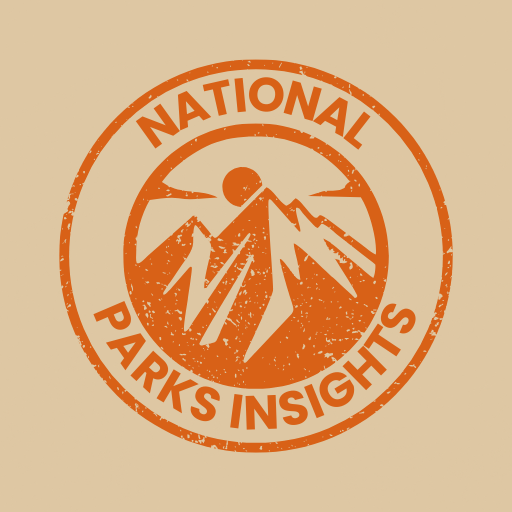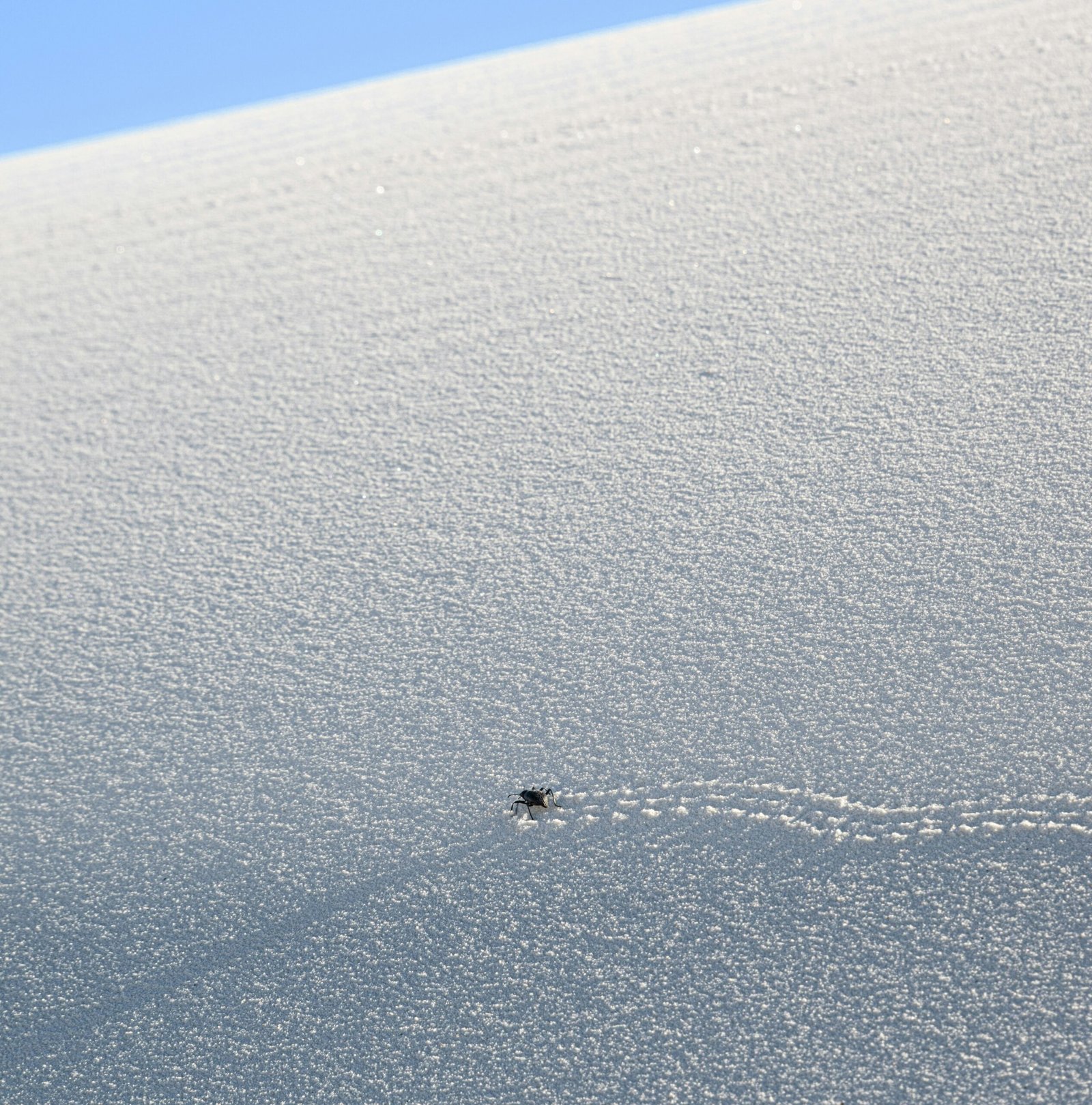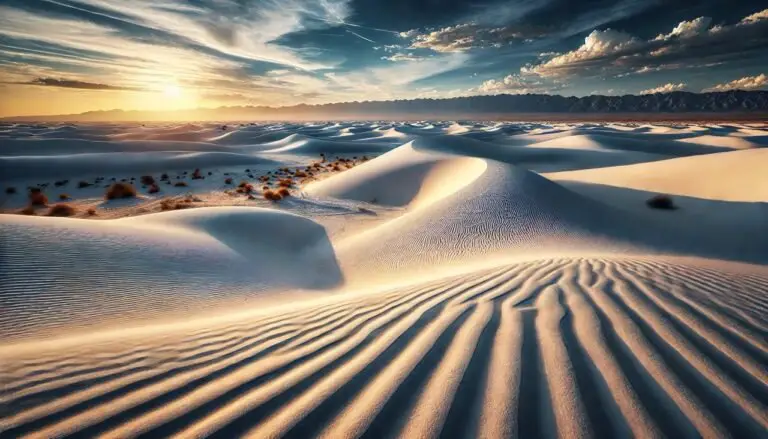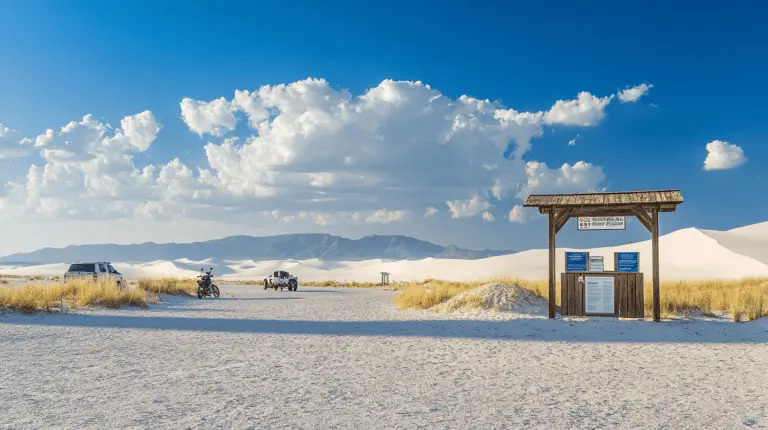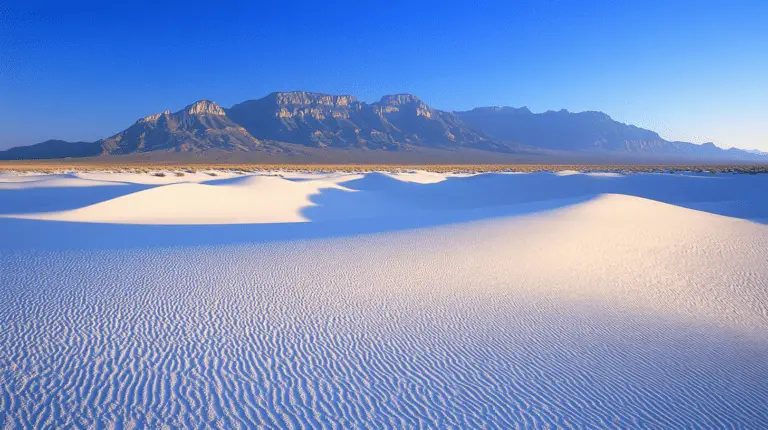Welcome to White Sands National Park, nestled in New Mexico. This spot boasts the world’s largest stretch of gypsum dunes, sprawling across 275 square miles of desert. Unlike your typical quartz dunes, these striking white hills are pure gypsum, making them shimmer in the sunlight. The NPS Official Website offers more.
There’s a heap of cool stuff to do here all year round. From ranger-guided tours to heart-racing dune sledding, and snapping those Insta-worthy shots of the dunes, there’s something to excite everyone. Feel like learning? Dive into the many educational programs on offer.
How Did These Dunes Get Here?
Believe it or not, the story of these dunes begins around 280 million years ago when the Permian Sea spread over the area. This ancient sea laid down thick layers of gypsum on the ocean floor. Fast forward a few millennia, and those gypsum beds turned into rock, shaping the land through some heavy-duty geological changes (NPS.gov).
The dance between erosion and renewal has been going on ever since, crafting and re-crafting the landscape (New Mexico Bureau of Geology & Mineral Resources). These natural forces keep the dunefield lively and continually reshaping. That’s why White Sands is a one-of-a-kind spot on Earth, hosting a unique ecosystem.
| Feature | Details |
|---|---|
| Area Size | 275 square miles |
| Age | 280 million years (Permian) |
| Main Component | Gypsum |
Curious about the nitty-gritty details of how these gypsum dunes came to be? Check out our deep dive on the Geology of White Sands National Park.
White Sands isn’t just a pretty place; it’s packed with history and mind-blowing natural phenomena. Planning a visit? Don’t forget to peek at the White Sands National Park map and get the lowdown on the park regs so you can have the best trip ever. Hungry for more history? Swing by our section on the park’s past.
Nature’s Quirks at White Sands National Park
How Climate and Water Shape This Place
White Sands National Park? It’s not just a pretty face with white dunes; it’s got a whole story arc impacted by climate and water. Situated at the end of a gigantic basin, White Sands collects water from nearby mountains, creating a cool oasis right in the middle of the desert (National Park Service). This is key because that moisture keeps those iconic white sands intact.
Summer rains play a vital role by soaking the ground and filling playas—those low-lying areas in the basin. This added moisture is the linchpin for the dunes’ stability. But when the climate misbehaves with prolonged drought, the whole system goes haywire (National Park Service).
The history of White Sands is an ever-evolving saga that goes back thousands of years. Around 10,000 years ago, higher temperatures and arid conditions dried up Lake Otero, leading to what we now know as Alkali Flat and Lake Lucero (National Park Service). These changes molded the Chihuahuan Desert’s current face, framing those spectacular dunes you see today.
| Weather Event | Effect on the Dunes |
|---|---|
| Rain | Raises groundwater, creates playas |
| Drought | Less moisture, dunes get flaky |
| Heat | Speeds up lake drying, playas form |
Resilient Critters All Over the Place
Who would’ve thought? Despite tough living conditions, White Sands is like a wildlife clubhouse. Tons of animals, mostly tiny invertebrates, hang out here. The park’s exclusive club includes around 45 species that you can’t find anywhere else, like 40 unique moth types (Wikipedia).
Larger animals also call White Sands home, including reptiles, birds, and mammals. These creatures have formed a sort of “circle of life” that keeps the place buzzing. The park’s harsh environment has led to some wild adaptations, helping these animals survive and thrive.
The park also boasts a treasure trove of ancient wonders. The oldest known human footprints in North America—aged 21,000 to 23,000 years—were unearthed here. These fossilized tracks reveal early human interactions with big, now-extinct animals like ground sloths and Columbian mammoths (Wikipedia). Talk about living history!
Want to dig deeper? Check out our sections on White Sands National Park animals and White Sands National Park plants for more juicy details.
| Critter Category | Examples | Exclusive to Park? |
|---|---|---|
| Insects | Moths, beetles | 45 species |
| Reptiles | Lizards, snakes | Nope |
| Birds | Roadrunners, hawks | Nope |
| Mammals | Coyotes, foxes | Nope |
Exploring White Sands is like stepping into a natural wonderland where both the dunes and the animals are stars of the show. Remember to tread lightly and follow our eco-friendly tips to help keep this place as amazing as you found it. For more on its rich history and unique geology, head over to White Sands National Park history and White Sands National Park geology.
Fun and Frolic Activities
White Sands National Park isn’t just a desert – it’s a giant natural playground with shimmering dunes in every direction. Adventure-seekers and those looking for some serene peace will find their sweet spot here.
What To Do
Loads of things to do at White Sands National Park let you experience its sandy beauty your way. Here’s a list of must-try fun stuff:
- Dunes Drive: Cruise through the heart of the sand dunes. Roll down your windows and soak in those killer views.
- Moonlight Hikes: Wander under the moonlit sky as the dunes glow like silver. Pure magic.
- Sunset Tours: Capture the fiery colors of the sunset as they play off the dunes. Perfect for those Insta-worthy shots.
- Hiking Trails: Easy and moderate trails where you can walk among the dunes and spot some desert plants. For more, check out White Sands hiking trails.
- Sand Play: Grab a sled and zoom down the dunes – it’s like the beach but way cooler. See more on sledding at White Sands sleds.
| Activity | What’s It Like |
|---|---|
| Dunes Drive | Scenic drive through dune field |
| Moonlight Hikes | Guided hikes under the moonlight |
| Sunset Tours | Evening tours with stunning colors |
| Hiking Trails | Strolls among dunes and plants |
| Sand Play | Sled down the dunes for fun |
Ranger-Led Fun
Wanna learn something cool? Join a ranger-led program. These fun and educational sessions give you juicy tidbits about the park’s history and nature.
- Guided Hikes: Explore the dunes with a super-knowledgeable ranger who’ll spill the tea on all things dunes, plants, and animals.
- Educational Talks: Get the lowdown on how these massive dunes formed, weather patterns, and the desert critters. Peep into White Sands geology for more awesome facts.
- Junior Ranger Program: Kids love this! Fun, interactive activities that teach young minds about the park.
- Special Events: From stargazing to cultural demos, these events show off the park’s unique charm.
For schedules and more activities, swing by the White Sands National Park visitor center.
| Program | What’s It About |
|---|---|
| Guided Hikes | Ranger-led strolls through dunes |
| Educational Talks | Geology, weather, and wildlife chats |
| Junior Ranger Program | Fun kid-friendly activities |
| Special Events | Stargazing and cultural demos |
White Sands National Park is a blast for everyone. Whether you’re driving, hiking, sledding, or soaking in a ranger program, you’ll have a whale of a time. Want to keep it green while you’re there? Check out eco-friendly tips.
Geological Formation
Welcome to White Sands National Park, where Mother Nature has outdone herself! This place isn’t just eye candy; it’s a living, breathing science experiment. Let’s peek behind the curtain to see what makes these dunes so spectacular.
Gypsum and Sand
Forget ordinary sand. The dunes here are made from gypsum, making White Sands National Park home to the world’s largest gypsum dunefield. Imagine this place underwater 280 million years ago when it was part of the Permian Sea. Over eons, that sea left behind gypsum, which eventually turned to stone.
Fast-forward to present day. The gypsum dunes are so fine and white, they might make you think you’re on another planet. This transformation starts on the surface of Lake Lucero and Alkali Flat every 10 to 14 years, thanks to big floods that concentrate gypsum in the water. Wind and water take care of the rest, grinding down the crystals until they’re nothing but fine gypsum sand.
Check out the gypsum formation action plan:
| Element | Cycle Duration | Process |
|---|---|---|
| Permian Sea | 280 million years ago | Gypsum settles on sea floor |
| Selenite Crystals | Every 10-14 years | Form on the lake surface |
| Breakdown | Ongoing | Wind and water break down crystals into sand |
Want to geek out more? Visit white sands national park geology and white sands national park gypsum.
Process of Dune Creation
Wind and water team up to make magic here. It starts with selenite crystals forming in the basin. Over time, wind and water erode these crystals into sand-sized grains. These grains, lighter than a feather, are then swept up by the wind and banged around with other particles and the ground until they become even finer.
Because gypsum is soft and easy to break, this cycle of breaking and re-depositing never really stops. That’s why the dunes are constantly moving and reshaping—the landscape here is always changing. It’s a never-ending show of Mother Nature’s craftsmanship.
For the best spots to see these natural processes in action, visit white sands national park location or grab a white sands national park map.
The more you know about how these gypsum dunes came to be, the more you’ll appreciate the surreal beauty of white sands new mexico. Ready to dive deeper into this scientific wonderland? Your adventure awaits!
Keep White Sands Clean and Green
Visit Wisely: Eco-Tips for Your Trip
Heading to White Sands National Park? Let’s make sure we leave it as beautiful as we found it. Simple steps can make a big impact (National Park Service):
- Use Vault Toilets: Stick to the park’s vault toilets. They’re there to keep things clean and the ecosystem healthy.
- Refillable Water Bottles: Bring a reusable water bottle. Fill it up at the park’s stations and keep those plastic bottles at bay.
- Reusable Bags: Carry your stuff in reusable bags. Let’s cut down on those pesky single-use plastics.
- Zero Waste Picnic: Pack your picnic with reusable containers, utensils, and cloth napkins. Tastes better, trust us.
- Trash and Recycling Bags: Got trash? Bring along bags to collect and properly dispose of your waste and recyclables.
- Save on Water and Energy: Be mindful with your water and energy use. Every drop and watt counts.
- Stick to Trails: Don’t wander off the beaten path. Stay on designated trails to protect plants and critters.
- Junior Ranger Fun: The Junior Ranger program is a blast. Learn all about park protection while having fun!
| Eco-Tip | What to Do |
|---|---|
| Use Vault Toilets | Use park-provided ones |
| Refill Water Bottles | Avoid those single-use plastics |
| Reusable Bags | Reduce plastic trash |
| Zero Waste Picnic | Pack with reusables |
| Bring Trash Bags | Collect and dispose of waste right |
| Save Water and Energy | Conscious usage |
| Stick to Trails | Protect plants and animals |
| Junior Ranger Program | Fun learning |
Keeping Nature Protected
White Sands National Park does a ton to protect its stunning dunes and critters. Here’s a peek at what they’re up to (NPS Official Website):
- Restoration Projects: They’re working hard to fix up disturbed parts of the park to look just as Mother Nature intended.
- Wildlife Gets VIP Treatment: They keep an eye on the local critters, especially those that only live in the dunes.
- Research and Monitoring: Ongoing studies help park stewards understand and manage the park’s natural dynamics.
- Education for Everyone: Ranger-led programs and other initiatives aim to teach visitors the importance of preserving this incredible place.
Pitch In and Get Involved
You can make a difference! Stick to park rules, join in on educational programs, and spread the word about why conservation is cool. For more fun stuff, check out ranger-led programs and dive into the historical significance of this awesome spot.
Keeping these dunes gleaming isn’t just a task—it’s a mission. For more tips on enjoying the park, browse our guides on white sands camping, hiking trails, and park maps. Let’s keep it pristine for the generations ahead.
Past Meets Present: White Sands National Park
Taking a trip to White Sands National Park isn’t just about gawking at those other-worldly dunes. It’s like opening a time capsule that’s packed with tales of ancient people and a solid conservation saga.
Humans in the Sands
For forever and a day, folks have been drawn to this gleaming expanse. Ages ago, early humans wandered these parts, living it up as hunters and gatherers. They didn’t leave Snapchat stories, but they did leave behind tools and trinkets that give us a peek into their daily grind.
This dune sea has seen it all. During the Spanish conquistador era, explorers couldn’t believe their eyes when they stumbled upon this endless white. Fast forward to the 20th century, and White Sands Missile Range adds a twist to the tale with its bomb-testing intrigue.
Becoming a National Park
Our story hits a high note in 1933 when President Herbert Hoover put White Sands on the map as a National Monument, thanks to the Antiquities Act of 1906. People were starting to buzz about preserving this unique spot with its gypsum dunes and crazy natural wonders (Wikipedia).
But wait, there’s more! After years of folks pushing for more protection, the big moment came on December 20, 2019. President Donald Trump flipped the switch, and in a poof—boom, National Park status! This wasn’t just a trophy moment—it was all about spotlighting its jaw-dropping vistas and saving its ecological and cultural vibe (Visit Las Cruces).
| Designation | Date | Authority |
|---|---|---|
| National Monument | 1933 | President Herbert Hoover |
| National Park | 2019 | Congress and President Donald Trump |
Leveling up to a National Park means more funds, more love, and more eyes on this gem. From ancient tribes to today’s status as a must-see, White Sands packs a story as rich as its scenery. Dig into its varied history and plot your adventure to soak in everything White Sands has to offer.
Need-to-know deets like visitor center, entrance fee, and weather are a click away in our other articles. Planning your visit just got easier!
